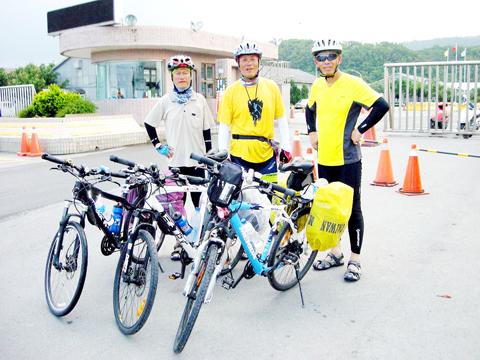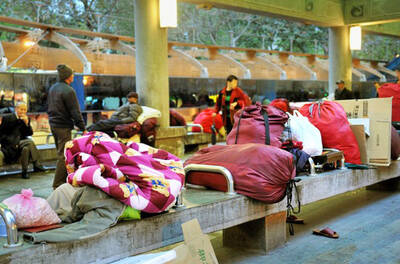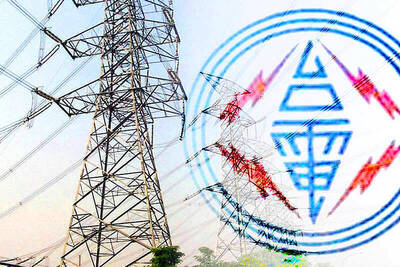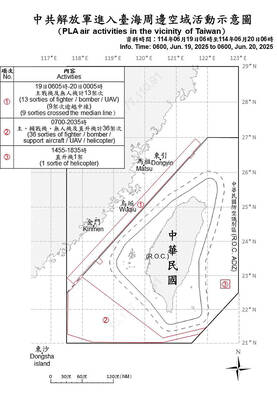Most radiation that humans come into contact with exists naturally in the environment and is harmless to human health, the Atomic Energy Council (AEC) said yesterday, adding that people should not be overly concerned about radiation hazards in their daily lives.
Last month, three AEC employees spent 10 days traveling around the country on their bikes. Five flat tires, two falls into gutters and some 300 or more radiation checks later, the trio returned to Taipei with data showing that radiation levels nationwide are within safety levels, AEC Radiation Monitoring Center director Huang Ching-chung (黃景鐘) said.
“Two-thirds of the radiation people experience in life exists in the environment naturally, while another third comes from medical treatments such as X-rays or MRI scans,” Huang said.

PHOTO: CNA
Radiation coming from nuclear plants or other nuclear devices combined contributes to less than 1 percent of total radiation, he added.
What is also important to know is that radiation — measured in alpha, beta or gamma rays — produces the same effect on human bodies despite its source, Huang said.
For example, cosmic gamma rays would have the same effect on the body as gamma rays produced by a nuclear plant, he said.
In terms of the radiation levels measured by the three bikers, “the highest gamma ray dose was 0.050 microsieverts per hour (μSv/h), measured on the Northern Cross-Island Highway (北橫公路), while the lowest was 0.023 μSv/h around Hualien,” Huang said.
“However, even if one looks at the ‘double’ amount, in reality they are both far below the 0.2 μSv/h safety level published by the AEC, and the differences should be regarded as insignificant and ascribed to natural variations,” he said.
The same conclusion also applies to areas to which the bikers did not trek, such as high mountains, where radiation levels are naturally stronger.
“Three major sources contribute to natural ionizing radiation in the environment — cosmic rays, gamma rays from the earth and sources in the atmosphere including radon gas,” Huang said.
Cosmic rays are stronger in higher latitudes, thereby strongest at the North Pole, Huang said, adding that high altitude regions atop mountains like Alishan are also affected more strongly by the rays.
But as the nation as a whole has a low level of radiation, the place with the “highest radiation” is not scientifically meaningful, and the public should not panic and avoid hiking even if the radiation level is above 0.2μSv/h, Huang said,
Citing the world’s four areas with the strongest levels of natural background radiation — Brazil’s Guarapari, China’s Yangjiang, India’s Kerala and Iran’s Ramsar — Huang said that while Guarapari is a prime tourist destination drawing crowds of visitors with its natural mud baths, major studies conducted in Yangjiang have found that nearby residents suffer from no long-term health maladies because of the radiation.
“The dose of natural background radiation in those places is hundreds of times higher than the 0.2 μSv/h level,” Huang said.

A year-long renovation of Taipei’s Bangka Park (艋舺公園) began yesterday, as city workers fenced off the site and cleared out belongings left by homeless residents who had been living there. Despite protests from displaced residents, a city official defended the government’s relocation efforts, saying transitional housing has been offered. The renovation of the park in Taipei’s Wanhua District (萬華), near Longshan Temple (龍山寺), began at 9am yesterday, as about 20 homeless people packed their belongings and left after being asked to move by city personnel. Among them was a 90-year-old woman surnamed Wang (王), who last week said that she had no plans

China might accelerate its strategic actions toward Taiwan, the South China Sea and across the first island chain, after the US officially entered a military conflict with Iran, as Beijing would perceive Washington as incapable of fighting a two-front war, a military expert said yesterday. The US’ ongoing conflict with Iran is not merely an act of retaliation or a “delaying tactic,” but a strategic military campaign aimed at dismantling Tehran’s nuclear capabilities and reshaping the regional order in the Middle East, said National Defense University distinguished adjunct lecturer Holmes Liao (廖宏祥), former McDonnell Douglas Aerospace representative in Taiwan. If

TO BE APPEALED: The environment ministry said coal reduction goals had to be reached within two months, which was against the principle of legitimate expectation The Taipei High Administrative Court on Thursday ruled in favor of the Taichung Environmental Protection Bureau in its administrative litigation against the Ministry of Environment for the rescission of a NT$18 million fine (US$609,570) imposed by the bureau on the Taichung Power Plant in 2019 for alleged excess coal power generation. The bureau in November 2019 revised what it said was a “slip of the pen” in the text of the operating permit granted to the plant — which is run by Taiwan Power Co (Taipower) — in October 2017. The permit originally read: “reduce coal use by 40 percent from Jan.

‘SPEY’ REACTION: Beijing said its Eastern Theater Command ‘organized troops to monitor and guard the entire process’ of a Taiwan Strait transit China sent 74 warplanes toward Taiwan between late Thursday and early yesterday, 61 of which crossed the median line in the Taiwan Strait. It was not clear why so many planes were scrambled, said the Ministry of National Defense, which tabulated the flights. The aircraft were sent in two separate tranches, the ministry said. The Ministry of Foreign Affairs on Thursday “confirmed and welcomed” a transit by the British Royal Navy’s HMS Spey, a River-class offshore patrol vessel, through the Taiwan Strait a day earlier. The ship’s transit “once again [reaffirmed the Strait’s] status as international waters,” the foreign ministry said. “Such transits by